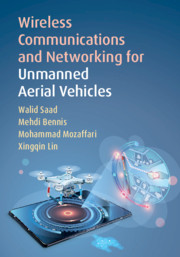Book contents
- Frontmatter
- Dedication
- Contents
- Acknowledgments
- 1 Wireless Communications and Networking with Unmanned Aerial Vehicles: An Introduction
- 2 UAV Applications and Use Cases
- 3 Aerial Channel Modeling and Waveform Design
- 4 Performance Analysis and Tradeoffs
- 5 Deployment of UAVs for Wireless Communications
- 6 Wireless-Aware Path Planning for UAV Networks
- 7 Resource Management for UAV Networks
- 8 Cooperative Communications in UAV Networks
- 9 From LTE to 5G NR-Enabled UAV Networks
- 10 Security of UAV Networks
- References
- Index
6 - Wireless-Aware Path Planning for UAV Networks
Published online by Cambridge University Press: 31 March 2020
- Frontmatter
- Dedication
- Contents
- Acknowledgments
- 1 Wireless Communications and Networking with Unmanned Aerial Vehicles: An Introduction
- 2 UAV Applications and Use Cases
- 3 Aerial Channel Modeling and Waveform Design
- 4 Performance Analysis and Tradeoffs
- 5 Deployment of UAVs for Wireless Communications
- 6 Wireless-Aware Path Planning for UAV Networks
- 7 Resource Management for UAV Networks
- 8 Cooperative Communications in UAV Networks
- 9 From LTE to 5G NR-Enabled UAV Networks
- 10 Security of UAV Networks
- References
- Index
Summary
This chapter delves into theproblem of wireless-aware path planning for UAVs with a focus on cellular-connected UAV user equipment (UAV UE) that can communicate with ground cellular networks. To this end, we present a very focused study on interference-aware path planning for cellular-connected UAV UEs, in which each UAV aims at achieving a tradeoff between various quality-of-service and mission goals, such as minimizingwireless latency and interference caused on the ground network. To this end, we first motivate the need for wireless-aware path planning for UAV UE and, then, we introduce a rigorous system model for a wireless network with UAV UEs. We then formally pose the wireless-aware path planning problem for UAV UEs using the framework of game theory. We subsequently provide a reinforcement learning solution that can be used to design autonomous, self-organizing wireless-aware path planning mechanisms for UAV UEs while balancing the various wireless and mission objectives of the drones. We also show how some of the unique features of UAVs, such as their altitude and their ability to establish line-of-sight, will have significant impact on the way in which their trajectory is designed.
Keywords
- Type
- Chapter
- Information
- Publisher: Cambridge University PressPrint publication year: 2020

